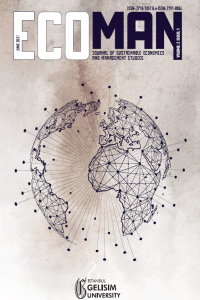Research Article
Year 2021,
Volume: 2 Issue: 1, 56 - 64, 14.04.2022
Abstract
The digital divide, exclusion of people from having access or the literacy to use digital technologies, is a term introduced by the emergence of personal computers and the world-wide-web. Although the technology and internet access rates have risen sharply and the term had started fading away from literature since its introduction in 1995, COVID-19 shifting the world online had played a significant role in the interruption of many students’ education, loss of jobs, and closing of organizations without a digital presence and/or reliable internet connection. The pandemic’s impacts have raised the question, “is the digital divide still continuing in today’s highly technological ecosystem?” This paper tries to answer this question and provides a brief history behind the digital divide, how and why it emerged, its social and economic impacts, how it shifted as years passed, possible solutions to close the gap, and what the future looks like in terms of global access to modern technologies. The findings of the study are expected to shed light on the" digitalization policies of the governments to secure digital equality and inclusion in societies.
References
- AYANSO, A., CHO, D. I., & LERTWACHARA, K. (2013). Information and Communications Technology Development and the Digital Divide: A Global and Regional Assessment. Information Technology for Development, 20(1), 60–77. https://doi.org/10.1080/02681102.2013.797378
- CHETTY, K., QIGUI, L., GCORA, N., JOSIE, J., WENWEI, L., & FANG, C. (2018). Bridging the digital divide: measuring digital literacy. Economics, 12(1). https://doi.org/10.5018/economics-ejournal.ja.2018-23
- CRUZ-JESUS, F., VICENTE, M., BACAO, F., & OLIVEIRA, T. (2016). The education-related digital divide: An analysis for the EU-28. Computers in Human Behavior, 56, 72–82. https://doi.org/10.1016/j.chb.2015.11.027 Deloitte: Quantifying the Economic Impact of Closing the Digital Divide. (2021, April 30). Deloitte United States. https://www2.deloitte.com/us/en/pages/about-deloitte/articles/press-releases/quantifying-the-economic-impact-of-closing-the-digital-divide.html
- ERUCHALU, C. N., PICHARDO, M. S., BHARADWAJ, M., RODRIGUEZ, C. B., RODRIGUEZ, J. A., BERGMARK, R. W., BATES, D. W., & ORTEGA, G. (2021). The Expanding Digital Divide: Digital Health Access Inequities during the COVID-19 Pandemic in New York City. Journal of Urban Health, 98(2), 183–186. https://doi.org/10.1007/s11524-020-00508-9 Examples of Digital Divide in the Modern Day. (2020, December 4). Maryville Online.https://online.maryville.edu/blog/examples-of-the-digital-divide/
- Google Trends. (n.d.). Google. https://trends.google.com/trends/explore?date=all&q=digital%20divide
- KOUADRI, N., & CHERIF, A. Impact of the Digital Divide on Economic Growth In Mena Countries Evidence From Panel ARDL Models 2000-2018.
- LAI, J., & WIDMAR, N. O. (2020). Revisiting the Digital Divide in the COVID-19 Era. Applied Economic Perspectives and Policy, 43(1), 458–464. https://doi.org/10.1002/aepp.13104
- MRACEK, K. (2021, December 9). What Is the Impact of the Digital Divide? Federal Reserve Bank of St. Louis. https://www.stlouisfed.org/open-vault/2018/november/impact-of-digital-divide
- NIETO, G. G. (2022, January 6). A view on digital divide and economic development. Diplo.https://www.diplomacy.edu/blog/view-digital-divide-and-economic-development /
- OECD. (n.d.). ICT Access and Usage by Households and Individuals. https://stats.oecd.org/Index.aspx?DataSetCode=ICT_HH2
- PRATT, M. K. (2019, July 26). ICT (information and communications technology, or technologies). TechTarget. https://www.techtarget.com/searchcio/definition/ICT-information-and-communications-technology-or-technologies
- RIDDLESDEN, D., & SINGLETON, A. D. (2014). Broadband speed equity: A new digital divide? Applied Geography, 52, 25–33.https://doi.org/10.1016/j.apgeog.2014.04.008
- SPARKS, C. (2013). What is the “Digital Divide” and why is it Important? Javnost - The Public, 20(2), 27–46. https://doi.org/10.1080/13183222.2013.11009113
- Statista. (2021, September 10). Worldwide digital population as of January 2021. https://www.statista.com/statistics/617136/digital-population-worldwide/#:%7E:text=How%20many%20people%20use%20the,the%20internet%20via%20mobile%20devices
- STEELE, C. (2019, February 23). What is the Digital Divide? Digital Divide Council. http://www.digitaldividecouncil.com/what-is-the-digital-divide/
- VOGELS, E. A., PERRIN, A., RAINIE, L., & ANDERSON, M. (2021, October 25). 53% of Americans Say the Internet Has Been Essential During the COVID-19 Outbreak. Pew Research Center: Internet, Science & Tech. https://www.pewresearch.org/internet/2020/04/30/53-of-americans-say-the-internet-has-been-essential-during-the-covid-19-outbreak/
- What is Broadband - Definition, Meaning & Explanation. (n.d.). Verizon Fios. https://www.verizon.com/info/definitions/broadband/#:%7E:text=Broadband%20is%20the%20transmission%20of,a%20high%20speed%20internet%20connection.&text=Broadband%20provides%20high%20speed%20internet,%2C%20cable%2C%20DSL%20and%20satellite
- ZADRAVEC-POWELL, L. (2017, March 6). Digital Divide: Economic. CL Simplex. https://clsimplex.com/asset/digital-divide-economic
There are 18 citations in total.
Details
| Primary Language | English |
|---|---|
| Subjects | Operation |
| Journal Section | Reviews |
| Authors | |
| Publication Date | April 14, 2022 |
| Published in Issue | Year 2021 Volume: 2 Issue: 1 |
Journal of Sustainable Economics and Management Studies (ECOMAN)
2718-1065 (Printed ISSN) & 2791-8084 (Electronic ISSN)
ecoman@gelisim.edu.tr

